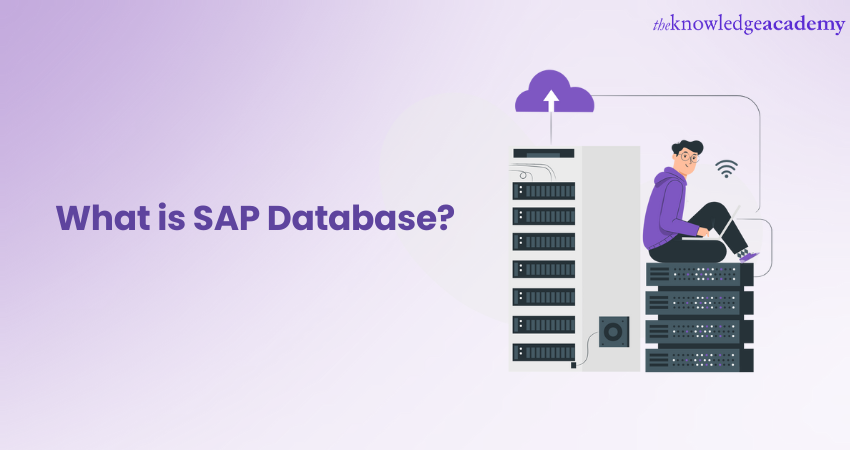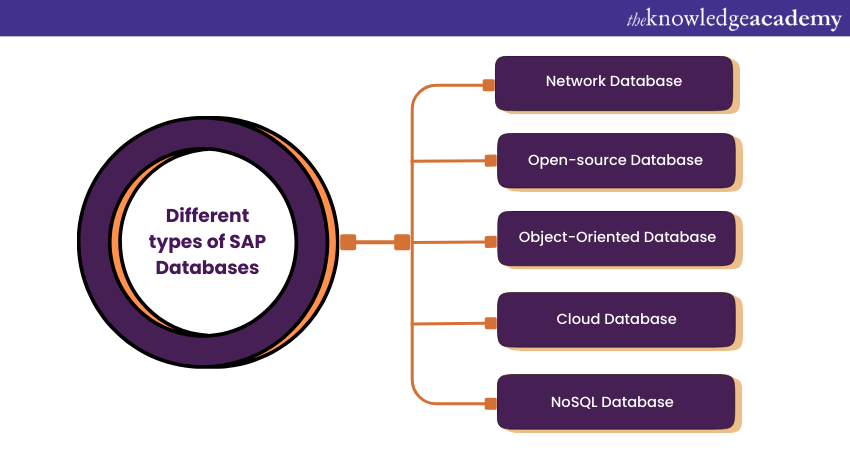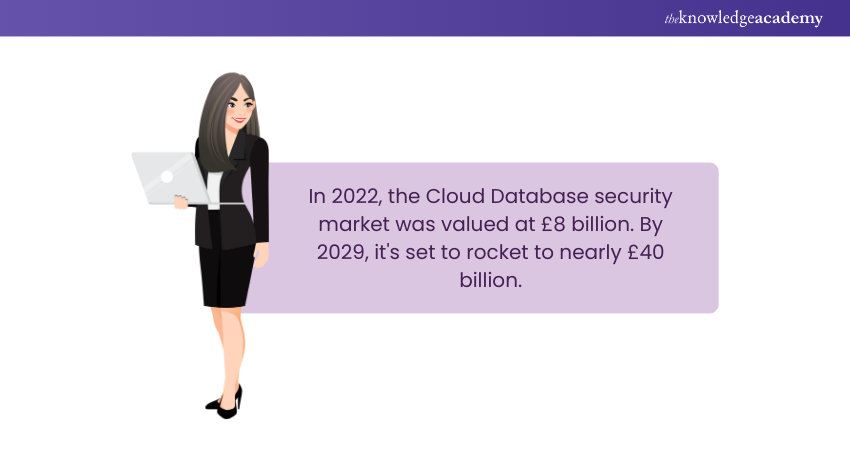We may not have the course you’re looking for. If you enquire or give us a call on + 1-866 272 8822 and speak to our training experts, we may still be able to help with your training requirements.
We ensure quality, budget-alignment, and timely delivery by our expert instructors.

Imagine a company where every decision is seamlessly driven by precise data, boosting efficiency and sparking innovation. What makes this possible? The secret lies in the SAP Database. Mastering this powerful tool is crucial for any business aiming to stay ahead of the competition. From its sophisticated architecture to practical examples, we'll uncover how this database empowers businesses to achieve their goals.
Ever wondered how businesses effortlessly manage vast amounts of data or ensure instant access to critical information? This comprehensive blog on the SAP Database will answer these questions and more. Dive in to explore its features, benefits, and real-world applications.
Table of Contents
1) What Does the SAP Database Mean?
2) SAP Database's Background
3) What are the Different Types of SAP Databases?
4) What are Some Examples of SAP Databases?
5) Conclusion
What Does the SAP Database Mean?
Systems, Applications and Products (SAP) Databases can be defined as an organised collection of structured data that helps facilitate OnLine Analytical Processing (OLAP) and OnLine Transition Processing (OLTP) for companies from different sectors. These companies belong to various sectors, such as banking, e-commerce, manufacturing, technology and healthcare. These Databases ensure that the data they store live up to the following features:
1) Accurate: This feature of the data ensures that the data does not have many errors and has no duplicate versions.
2) Complete: This feature of the data ensures that the data has no missing values.
3) Relevant: This feature of the data ensures that the data used for analysis is completely updated and relevant to the necessary context.
4) Conformant: This feature of the data ensures that the data follows a given set of rules and standardised formats that are defined as part of an organisation’s Data Management strategy process.
5) Consistent: This feature of the data ensures the uniformity and consistency of data as it is transferred between systems and applications.
6) Secure: This feature of the data ensures that it is secure from unauthorised attacks, data breaches or corruption.
SAP Database's Background
a) Evolution of Databases:
a) Initially limited to flat-file systems.
b) Evolved into relational and object-relational systems.
c) Each type has specific use cases.
b) Early Database Systems:
a) Originated in 1968 as file-based systems.
b) Benefits of SAP included ordered data and convenient storage.
c) Limited by the technology of the time.
d) Allowed data access sequentially, randomly, or by indexing.
c) SAP Database Management System (DBMS):
a) Known for its platform-independent nature.
b) Combines features of Oracle and Informix databases.
c) SAP Modules can be extended like Oracle.
d) Possesses an advanced database engine similar to Informix.
d) Programming Languages and Databases:
a) SAP Database often requires programming language support.
b) Modern languages like Python and Java are commonly used today.
c) Early SQL usage involved third-generation languages like COBOL and BASIC, which predated C.
Enhance your career and streamline financial processes by registering in our SAP Finance and Controlling (FICO) Training.
What are the Different Types of SAP Databases?
There are several types of SAP Databases, all of which we will explore in detail below:

1) Network Database
A Network Database consists of multiple member files or records linked to multiple owner files and vice versa. A Network Database provides multiple owners with various data access paths. The Database can be imagined as an upside-down tree, where the member information represents the branches leading to the owner at the bottom – and every fragment of data is eventually connected to the main data.
Network databases allow more natural modelling of relationships between records and entities. It is also more flexible and accessible, which results in faster search, navigation, and access to data. An example of a network database is SAP HANA, which consists of components that facilitate system communication with the help of networking channels. For a comprehensive understanding of how to optimise these features, a SAP S/4HANA Guide can provide valuable insights into leveraging the full potential of SAP HANA for improved data management.
2) Open-source Database
An Open-source Database has a code that can be accessed publicly and is free to download, re-use and modify. This Database stores important information that organisations control. Users can use the Database to create their systems in accordance with their business requirements and modify the source code according to their preferences.
Users of Open-source Databases do not require any payment for using the code, unlike Commercial Databases, where users pay to use larger datasets or access additional features. These Databases are cost-effective and flexible to use. An example of such an Open-source Database is SAP MaxDB.
3) Object-oriented Database
Object-oriented Database Management Systems (OODBMS) make code easier to manage as they help integrate Database functionality into Object-oriented Programming languages. Such Object-oriented Databases incorporate Relational Database principles. An OODBMS is known to use the following:
1) Objects: Objects are building blocks of classes with either built-in or user-defined types.
2) Class: A class determines the behaviour of an object.
3) Methods: The methods of a class determine its behaviour.
4) Pointer: A pointer helps access elements of an object Database and establish relationships among objects.
Using Object-oriented Databases has several advantages. The advantages include transparency, easy retrieval, seamless integration, and persistent storage. Users are allowed to store all the properties of data objects in the Database, and the Database continues to store them after the program terminates. Upon restarting the program, the Database can retrieve an object with the specified properties. This facilitates the storage and retrieval of complex data objects transparently. For a deeper insight into these capabilities, the SAP Cheat Sheet Guide provides a valuable reference. For those implementing enterprise systems like SAP, referring to the SAP Implementation Methodology Guide can be highly beneficial as it offers insights on integrating such databases effectively within your SAP framework.
Get Interview-Ready – Practice with SAP Interview Questions Now!
4) Cloud Database
A Cloud Database can be defined as a Database hosted on a Cloud server which can be accessed through a web interface or Applicating Programming Interface (API). Much like traditional Databases, these Cloud Databases provide several functionalities.

However, they facilitate secure data storage without the organisation investing in expensive hardware. Cloud Databases are known to support Relational Databases such as Structure Query Language (SQL) and NoSQL Databases such as MongoDB. Their common features include the following:
1) Scalability: This feature helps businesses easily manage large volumes of data without affecting the overall performance.
2) Elasticity: This feature means businesses can increase or decrease the number of data nodes per their specific requirement.
3) Security: This feature assures that the data stored in the Cloud is safe from any possible theft or unauthorised data breaches.
4) Redundancy: This feature means businesses can ensure their data despite server failures due to regular backups.
5) Manageability: This final feature means that IT teams can conveniently perform several administrative operations on the Database.
5) NoSQL Databases
NoSQL refers to all the Database technologies which do not use Simple Query Languages as the primary language while accessing data. These kinds of Databases are different from Relational Databases, as they do not require a predefined schema - a feature that makes them great for semi structured or unstructured data. These Databases are often referred to as Non-relational Databases. Some of its features include:
1) Modifiability: Programmers can modify the NoSQL Database in real time.
2) Integrity: Modifying data in this Database does not affect the applications.
3) Versatility: This Database can benefit from technologies like Apache Cassandra, MongoDB, CouchDB, and CouchBase.
Enhance the skills to streamline logistics and elevate your career by joining our SAP Supply Chain Management Training.
What are Some Examples of SAP Databases?
Now that we have discussed what an SAP Database is as well as the types of SAP Databases, we will look at a few examples of SAP Databases now.
1) SAP HANA
SAP High-Performance Analytic Appliance (HANA) is a multi-model Database that facilitates using multiple data models using a single back-end. As with traditional Databases, an SAP HANA Database stores data in its memory rather than on a disk, which facilitates faster data access than Disk or Solid-State Drives (SSD).
The Database supports the search, analytics and integration of structured and unstructured data. It also helps develop smart, insight-driven applications through real-time data, in-memory computing and machine learning. One can access these features both on the Cloud and on-premises.
2) SAP IQ
SAP Intelligent Query (IQ) is a column-based, Relational Database system that facilitates Business Intelligence (BI), data warehousing and data marts. The two principal components of SAP IQ are clients and servers, both of which provide their own features to the Database. The client components provide connectivity, SQL command pursuing, authentication, monitoring and administration via the web. The server components provide features such as column stores, query engines, parallel data loading engines, Database encryption, authorisation and scalability.
3) SAP ASE
SAP Adaptive Server Enterprise (ASE) is a Relational Database server known to handle large volumes of data and users simultaneously. This feature of the SAP ASE Database ensures reliability, accessibility and performance across multiple industries. It also facilitates the processing of mission-critical transactions while maintaining high levels of performance and availability.
These Databases also possess flexible SQL systems that decrease risk and improve agility. The SAP ASE is also resource-efficient, meaning that it helps organisations lower their operational costs.
4) Oracle Runtime Database
Oracle Runtime Database is multi-platform document store which allows you to access data regardless of your device type and its Operating System (OS). This allows clients to work using different programming languages like Android, JavaScript, and iOS while using an instance of a Realtime Database.
Oracle Runtime Database is accessible on both mobile and website platforms. Additionally, it ensures seamless updates with the latest data control features, making it a valuable tool for database management. Professionals using this technology may also consider the Average Salary prospects of an Oracle Database Administrator when evaluating career opportunities in this field.
5) SAP MaxDB
SAP MaxDB Database is known for the consistent structure of its data. This is possible due to the application data and the metadata within the metadata having a unique name, allowing for consistent formatting.
6) Microsoft SQL Server
Microsoft SQL Server is one of the leading figures in the domain of Databases It is a Relational Database Management tool which is capable of supporting multiple applications. The usage of this server includes transaction, processing, and analysis.
7) IBM Db2
IBM Db2 is a collection of products, which is frequently used for Database Management. Db2 is one of the most popular AI- powered tools in this Database, capable of helping with both structured and unstructured Data Management. The Db2 range of tolls simplify the data handling process, by allowing you to take advantage of AI.
Get fully prepared for your SAP interview! Check out the ultimate SAP Interview Questions and Answers guide now.
Conclusion
SAP Database stands as a cornerstone for businesses striving to harness the power of data. Its sophisticated architecture and practical applications enable companies to manage vast amounts of information efficiently and access critical data instantly. By mastering this database, businesses can drive innovation, enhance decision-making, and maintain a competitive edge in today's fast-paced market. Additionally, having an understanding of the SAP Consultant Salary can help organisations allocate the right resources for database management and implementation.
Become a project planning and execution expert – sign up for our Microsoft Project Training today!
Frequently Asked Questions
How Does SAP HANA Differ from Traditional Databases?

SAP HANA is an in-memory database that enables real-time data processing, unlike traditional databases reliant on disk-based storage. It combines transactional and analytical capabilities, delivering faster data retrieval and complex analysis.
How Does SAP Handle Database Security and Data Protection?

SAP ensures robust security through encryption, access controls, and role-based permissions. It complies with data protection regulations, offering audit trails, secure backups, and data masking.
What are the Other Resources and Offers Provided by The Knowledge Academy?

The Knowledge Academy takes global learning to new heights, offering over 3,000 online courses across 490+ locations in 190+ countries. This expansive reach ensures accessibility and convenience for learners worldwide.
Alongside our diverse Online Course Catalogue, encompassing 19 major categories, we go the extra mile by providing a plethora of free educational Online Resources like News updates, Blogs, videos, webinars, and interview questions. Tailoring learning experiences further, professionals can maximise value with customisable Course Bundles of TKA.
What is The Knowledge Pass, and How Does it Work?

The Knowledge Academy’s Knowledge Pass, a prepaid voucher, adds another layer of flexibility, allowing course bookings over a 12-month period. Join us on a journey where education knows no bounds.
What are the Related Courses and Blogs Provided by The Knowledge Academy?

The Knowledge Academy offers various SAP Training, including the SAP Finance and Controlling FICO Training, SAP Financial Accounting Course, and SAP IQ Training. These courses cater to different skill levels, providing comprehensive insights into Benefits of SAP.
Our IT Infrastructure & Networking Blogs cover a range of topics related to SAP Frameworks, offering valuable resources, best practices, and industry insights. Whether you are a beginner or looking to advance your Information Technology (IT) and Networking skills, The Knowledge Academy's diverse courses and informative blogs have got you covered.
Upcoming Programming & DevOps Resources Batches & Dates
Date
 SAP Finance and Controlling FICO Training
SAP Finance and Controlling FICO Training
Mon 19th May 2025
Mon 21st Jul 2025
Mon 15th Sep 2025
Mon 17th Nov 2025
Mon 15th Dec 2025
Mon 2nd Feb 2026
Mon 27th Apr 2026
Mon 22nd Jun 2026
Mon 5th Oct 2026






 Top Rated Course
Top Rated Course



 If you wish to make any changes to your course, please
If you wish to make any changes to your course, please


